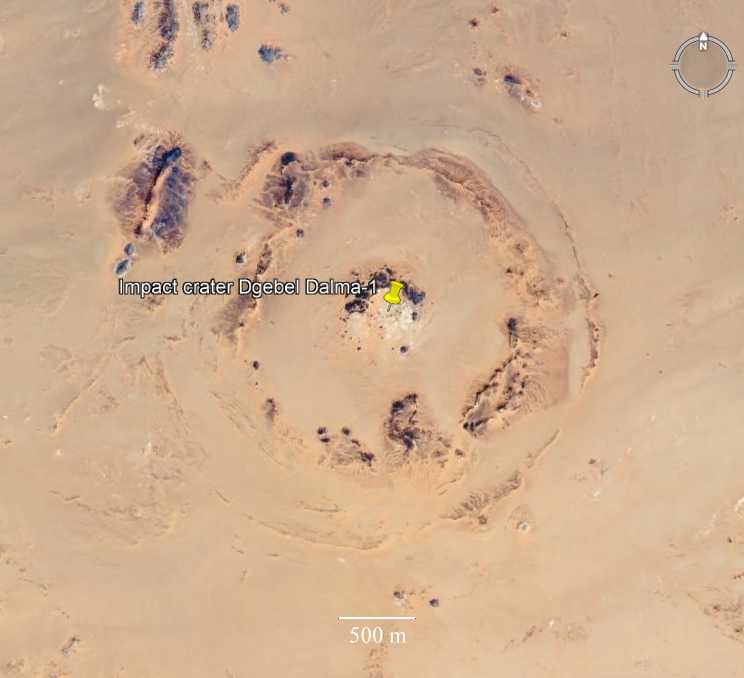
Спутниковая фотография кратера из Google Earth.

В Северной Африке установлено несколько парных кратеров одинакового возраста, что позволяет определить направления прилета МТ для поисковых работ на диатремы. Это:
1) Оазис (18 км) и В.Р.S. (2 км), Ливия, <120 млн. лет;
2) Аркену-1 (6,8 км) и Аркену-2 (10 км), Ливия,< 140 млн. лет.
(Хазанович-Вульф, 2007).
The BP structure is located in southeastern Libya, 165km northeast of the Kufra Oasis and about 80km from the Oasis impact structure. BP is 2.8 km in diameter and occurs in the Cretaceous Nubian sandstone. BP consists of two discontinuous rings of hills, with a central structure in the middle. BP has experienced heavy erosion, to such an extent that the southern half of the central uplift block has been eroded to the level of the crater bottom. The rings of hills do not get any higher than 30m, and the inner ring is more structurally deformed than the outer ring. The central block has a diameter of 0.6km, and a maximum relief of 38m. Bedding within this central block is intensely JOINTED Две структуры расположены на юго-востоке Ливии и сильно эродированы. Мишенью служит нижнемеловой песчаник свиты Нубия. Выполнены петрографические, геохимические и изотопные исследования образцов мишени. Содержания главных и следовых элементов в породе мишени обеих структур и в образцах стекол Ливийской пустыни уверенно коррелируют. Содержание тугоплавких следовых элементов в стеклах в среднем несколько выше, чем в породе мишени. Редкоземельные элементы в стеклах и в породе мишени имеют сходные содержания и показывают сходство с постархейскими породами верхней части коры. Отношения {87}Sr/{}86Sr и {143}Nd/{144}Nd обеих структур и стекол схожи и также показывают характеристики пород верхней части континентальной коры. Полученные данные приводят к выводу о содержании родительского вещества стекол в породе мишени. Необходимо получить возрасты обеих структур для окончательного подтверждения связи стекол со структурами
The proximity of the BP structure to the Oasis structure has led to the suggestion that the two craters formed at the same time during a double impact event. Also lending to this idea are the similar levels of erosion at both craters, which are both very highly eroded, and both are present in Nubian sandstone.
Shock metamorphism is abundant in the Nubian sandstones at the BP structure. The most diagnostic features are open fractures and planar deformation features, which are quite abundant. Planar deformation fractures are present but poorly developed, which probably suggests low peak shock pressures. Shock lamellae are extremely well developed, with as many as nine distinct sets occurring in one quartz grain. These features are extremely similar, if not identical, to the shock metamorphic features found at the Oasis structure.
The BP structure, and the Oasis structure, has been suggested as the source of the Libyan Desert Glass (EXAMPLE
Compositional similarities between rocks from these craters and the Libyan Desert Glass have led to a tentative conclusion that the glass and the craters are connected. However, the uniformity of the local rocks makes it difficult to establish an undeniable link.
The age of the BP structure is difficult to constrain, since there is no impact melt. The age of the Nubian sandstone is late Cretaceous, so the time of the impact event can be limited to between now and ~100 million years ago.
(Global Impact Studies Project).
Обзор статей (из РЖ ВИНИТИ "Геология и геофизика"):
(Abate, Koeberl, Kruger, Underwood, 1999).
На главную